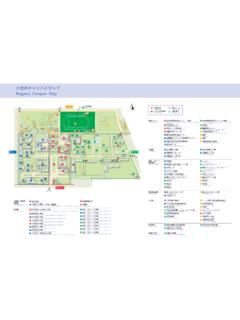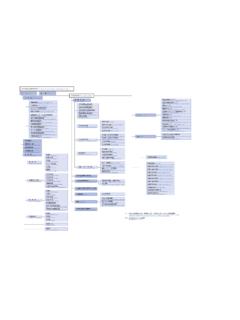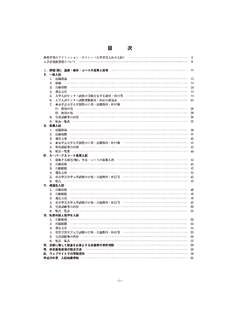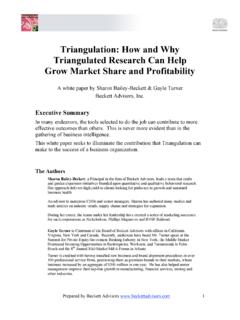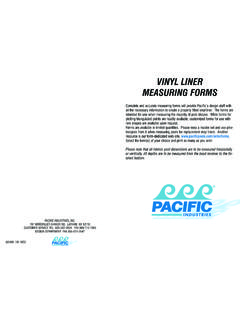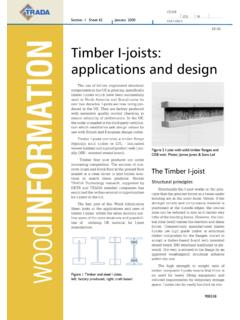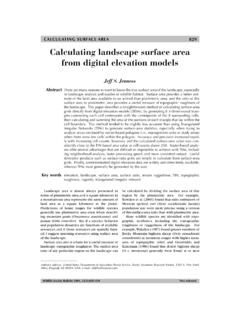Transcription of Derived Categories - u-gakugei.ac.jp
1 Derived CategoriesMistuo HoshinoContents 01. Cochain complexes 02. Mapping cones 03. Homotopy Categories 04. Quasi-isomorphisms 05. Mapping cylinders 06. Triangulated Categories 07. paisse subcategories 08. Quotient Categories 09. Quotient Categories of triangulated Categories 10. Derived Categories 11. Hyper Ext 12. Localization in triangulated Categories 13. Right Derived functors 14. Left Derived functors 15. Double complexes 16. Left exact functors of finite cohomological dimension 17. Derived functors of bi- -functors 18. The right Derived functor of Hom 19. The left Derived functor of 20. Hyper Tor 21. Universal coefficient theorems 22.
2 Way-out functors 23. Lemma on way-out functors 24. Connections between RHom and L 25. Duality in Coherent rings 1. Cochain complexes Throughout this section, ! is an abelian category and ( (resp. 3) is the collection ofinjective (resp. projective) objects of !. Unless otherwise stated, functors are covariantfunctors. Definition We denote by !Z the category of Z-graded objects in !, , an object of!Z is a family X = {Xn}n Z with the Xn Ob(!) and a morphism u : {Xn} {Yn} is a familyu = {un}n Z with the un !(Xn, Yn). We have an autofunctor T : !Z !Z, called a shiftfunctor, such that (TX)n = Xn + 1 for X Ob(!))
3 Z) and (Tu)n = un + 1 for u !Z(X, Y). Remark Each X Ob(!) is considered as a family {Xn}n Z such that X 0 = X and Xn =0 for n 0, so that we get a full embedding ! !Z. Definition A cochain complex X = (X, dX) in ! is a pair of X Ob(!Z) and dX !Z(X, TX) with TdX o dX = 0, where X is called the underlying Z-graded object and dX iscalled the differential. A morphism u : X Y of cochain complexes is defined as amorphism u !Z(X, Y) such that Tu o dX = dY o u. We denote by C(!) the category ofcochain complexes in !. We have an autofunctor T : C(!) C(!), called the translation,such that TX = (TX, TdX) for X = (X, dX).
4 Sometimes, Tn(X ) is denoted by X [n]. Remark (1) Each X Ob(!Z) is considered as a cohain complex with dX = 0, so thatwe get a full embedding !Z C(!). Then X = n Z T n(Xn), the direct sum in C(!), for allX = {Xn}n Z Ob(!Z). (2) We set X = (X, dX) for X Ob(C(!)). Then X > X for all X Ob(C(!)). Proposition C(!) is an abelian category. Proof. For each u C(!)(X , Y ), Ker u and Cok u are defined by the followingcommutative diagram with exact rows: 0 Ker un Xn Yn Cok un 0 dXn dYn 0 Ker un + 1 Xn + 1 Yn + 1 Cok un + 1 0 .1 Then Im u > Coim u canonically, so that we may identify Im u with Coim u. Also, the directsum of two cochain complexes X , Y is defined as followsX Y = (X Y, ddXY00 ).
5 Definition We define additive covariant functors Z , B , Z, B and H : C(!) !Z as follows: Zn(X ) = Ker dXn,Bn(X ) = Im dXn 1,Z n(X ) = Cok dXn 1,B n(X ) = Coim dXn = Im dXn = Bn + 1(X ),Hn(X ) = Zn(X )/Bn(X ).for X Ob(C(!)) and n Z. Remark (1) B = T o B . (2) For any X Ob(C(!)), dX admits an epic-monic factorization X B(X ) T(X ). Lemma (1) Z : C(!) !Z is left exact and Z : C(!) !Z is right exact. (2) We have a commutative diagram of functors with exact rows and columns 00 0 B Z H 0|| 0 B 1C(!) Z 0 B B (3) We have an exact sequence of functors 0 H Z T o Z T o H 0. Proof. (1) Let 0 X Y Z 0 be an exact sequence in C(!)
6 Applying Snakelemma to the commutative diagram with exact rows 0 X Y Z 0dX dY dZ0 T(X ) T(Y ) T(Z ) 0,we get an exact sequence0 Z (X ) Z (Y ) Z (Z ) Z(T(X )) Z(T(Y )) Z(T(Z )) 0. (2) Straightforward. (3) In the diagram of the part (2), since B = T o B , we can splice the top row, shifted byone, with the right end column to get a desired exact sequence. Proposition Let 0 X Y Z 0 be an exact sequence in C(!). Then wehave a long exact sequence in ! L Hn(X ) Hn(Y ) Hn(Z ) n Hn + 1(X ) L . Proof. By Lemma (1) we have a commutative diagram with exact rows Z(X ) Z(Y ) Z(Z ) 0 0 T(Z (X )) T(Z (Y )) T(Z (Z )) ,to which we apply Snake lemma.
7 Then by Lemma (3) we get an exact sequence in !ZH (X ) H (Y ) H (Z ) T(H (X )) T(H (Y )) T(H (Z )). Definition Let @ be another abelian category. Then every additive covariant ( ) functor F : ! @ can be extended to an additive covariant (resp. contravariant)functor F : C(!) C(@) as follows: if F : ! @ is covariant, then F : C(!) C(@)associates with each X Ob(C(!)) a cochain complex FX such that (FX )n = F(Xn) anddFXn = F(dXn) for all n Z; and if F : ! @ is contravariant, then F : C(!) C(@)associates with each X Ob(C(!)) a cochain complex FX such that (FX )n = F(X n) anddFXn = F(dXn ()+1) for all n Z.
8 Proposition Let @ be another abelian category and F : ! @ an additive for the extended functor F : C(!) C(@) the following hold. (1) If F is covariant, then F o T = T o F. (2) If F is contravariant, then F o T = T 1 o F. Proof. Straightforward. Proposition Let @ be another abelian category and F : ! @ an exact for the extended functor F : C(!) C(@) the following hold. (1) If F is covariant, then F o Hn > Hn o F for all n Z. (2) If F is contravariant, then F o Hn > H n o F for all n Z. Proof. Straightforward Definition We denote by U : C(!) !Z the underlying functor, , U associateswith each complex X = (X, dX) its underlying Z-graded object X.
9 Proposition Let U : C(!) !Z denote the underlying functor. Then the followinghold. (1) U is exact and has both a right adjoint S : !Z C(!) which associates with eachZ-graded object X a complex S(X) = (TX X, 0010 )and a left adjoint T 1 o S : !Z C(!). (2) We have an exact sequence of functors 0 1111C(!) S o U T 0,where = t[d 1], = [1 d].4 Proof. (1) It is obvious that U is exact. For any X Ob(C(!)) and Y Ob(!Z), wehave natural isomorphisms !Z(U(X ), Y) C(!)(X , S(Y)), u a Tu duXo , !Z(Y, U(X )) C(!)(T 1S(Y), X ), u a [u T 1(dX o u)]. (2) Straightforward. Remark (1) T o S > S o T.
10 (2) Let X Ob(C(!)). If the canonical exact sequence 0 X X S(U(X )) X TX 0splits, then X > S(Z (X )). (3) An object I Ob(!Z) is injective if and only if so is S(I) Ob(C(!)). (4) An object X Ob(C(!)) is injective if and only if X > S(I) with I Ob(!Z)injective. Definition An abelian category ! is said to have enough injectives (resp. projectives)if for each X Ob(!) there exists a monomorphism X I with I ( (resp. an epimorphismP X with P 3). Lemma Let + be a subcollection of Ob(!) containing zero objects and closed underfinite direct sums and assume for any X Ob(!) there exists a monomorphism X I in !)
